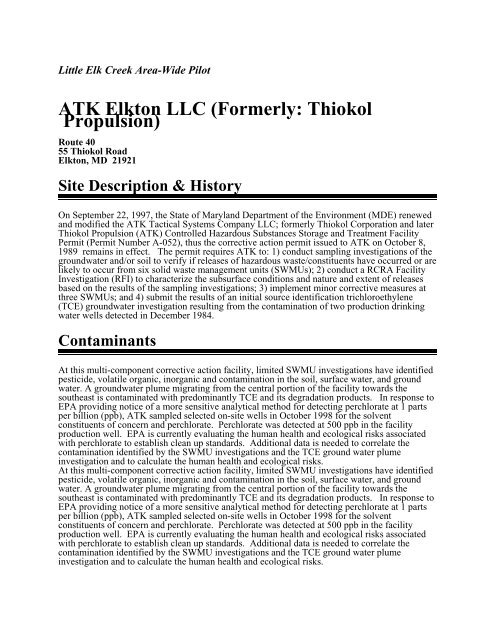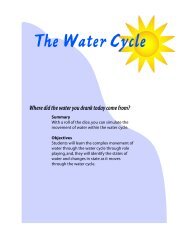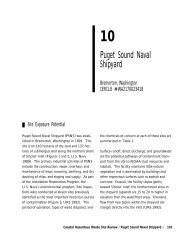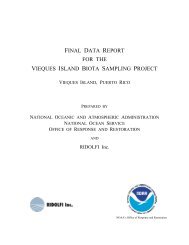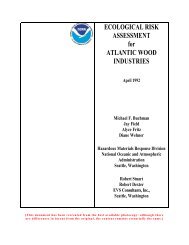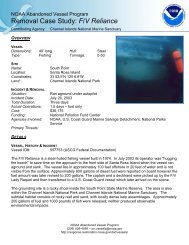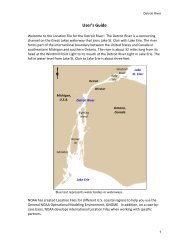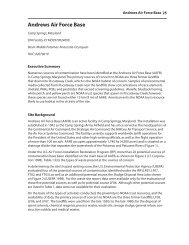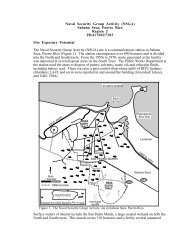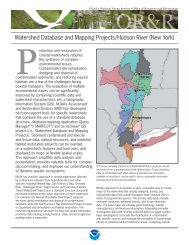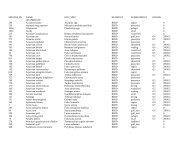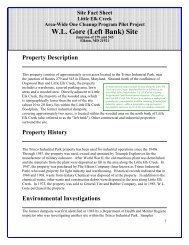Fact Sheet - Thiokol/ATK Tactical Systems
Fact Sheet - Thiokol/ATK Tactical Systems
Fact Sheet - Thiokol/ATK Tactical Systems
You also want an ePaper? Increase the reach of your titles
YUMPU automatically turns print PDFs into web optimized ePapers that Google loves.
Little Elk Creek Area-Wide Pilot<br />
<strong>ATK</strong> Elkton LLC (Formerly: <strong>Thiokol</strong><br />
Propulsion)<br />
Route 40<br />
55 <strong>Thiokol</strong> Road<br />
Elkton, MD 21921<br />
Site Description & History<br />
On September 22, 1997, the State of Maryland Department of the Environment (MDE) renewed<br />
and modified the <strong>ATK</strong> <strong>Tactical</strong> <strong>Systems</strong> Company LLC; formerly <strong>Thiokol</strong> Corporation and later<br />
<strong>Thiokol</strong> Propulsion (<strong>ATK</strong>) Controlled Hazardous Substances Storage and Treatment Facility<br />
Permit (Permit Number A-052), thus the corrective action permit issued to <strong>ATK</strong> on October 8,<br />
1989 remains in effect. The permit requires <strong>ATK</strong> to: 1) conduct sampling investigations of the<br />
groundwater and/or soil to verify if releases of hazardous waste/constituents have occurred or are<br />
likely to occur from six solid waste management units (SWMUs); 2) conduct a RCRA Facility<br />
Investigation (RFI) to characterize the subsurface conditions and nature and extent of releases<br />
based on the results of the sampling investigations; 3) implement minor corrective measures at<br />
three SWMUs; and 4) submit the results of an initial source identification trichloroethylene<br />
(TCE) groundwater investigation resulting from the contamination of two production drinking<br />
water wells detected in December 1984.<br />
Contaminants<br />
At this multi-component corrective action facility, limited SWMU investigations have identified<br />
pesticide, volatile organic, inorganic and contamination in the soil, surface water, and ground<br />
water. A groundwater plume migrating from the central portion of the facility towards the<br />
southeast is contaminated with predominantly TCE and its degradation products. In response to<br />
EPA providing notice of a more sensitive analytical method for detecting perchlorate at 1 parts<br />
per billion (ppb), <strong>ATK</strong> sampled selected on-site wells in October 1998 for the solvent<br />
constituents of concern and perchlorate. Perchlorate was detected at 500 ppb in the facility<br />
production well. EPA is currently evaluating the human health and ecological risks associated<br />
with perchlorate to establish clean up standards. Additional data is needed to correlate the<br />
contamination identified by the SWMU investigations and the TCE ground water plume<br />
investigation and to calculate the human health and ecological risks.<br />
At this multi-component corrective action facility, limited SWMU investigations have identified<br />
pesticide, volatile organic, inorganic and contamination in the soil, surface water, and ground<br />
water. A groundwater plume migrating from the central portion of the facility towards the<br />
southeast is contaminated with predominantly TCE and its degradation products. In response to<br />
EPA providing notice of a more sensitive analytical method for detecting perchlorate at 1 parts<br />
per billion (ppb), <strong>ATK</strong> sampled selected on-site wells in October 1998 for the solvent<br />
constituents of concern and perchlorate. Perchlorate was detected at 500 ppb in the facility<br />
production well. EPA is currently evaluating the human health and ecological risks associated<br />
with perchlorate to establish clean up standards. Additional data is needed to correlate the<br />
contamination identified by the SWMU investigations and the TCE ground water plume<br />
investigation and to calculate the human health and ecological risks.
Investigation, Cleanup & Next Steps<br />
The initial investigations were conducted over a period of approximately four years at six of the<br />
SWMUs. EPA’s final approval of five of the SWMU investigations issued in 1997 and 1998<br />
identified the need for performing a site wide investigation of the groundwater and soil.<br />
The approved recommended minor corrective measures required by the permit were previously<br />
implemented at the three SWMUs in 1986 and 1987.<br />
The initial TCE source identification groundwater investigation and residential well survey was<br />
performed in 1987. The investigation and survey were undertaken as a result of a consent<br />
agreement between <strong>ATK</strong> and the Maryland Department of Health and Mental Hygiene<br />
(MDHMH) entered on March 30. 1987. Further TCE groundwater investigations were<br />
performed in 1988 and 1995 based on recommendations of each earlier investigation and<br />
groundwater monitoring program implemented. The 1995 investigation and the monitoring<br />
program results identified the need for further investigation in the southern area of the facility<br />
and the potential threat to residential wells not previously connected to public water supply<br />
resulting from the earlier residential well survey and sampling in 1988. To address the findings<br />
of the TCE groundwater investigations and monitoring results, <strong>ATK</strong> implemented two interim<br />
measures. <strong>ATK</strong> installed a groundwater pump and treatment system with a stripping tower in<br />
the 1980s and on July 1, 1998 installed additional capture wells and a second stripping tower.<br />
The results of the monitoring program revealed that the second well containment system has not<br />
adequately captured the plume and the stripping towers are not effectively reducing the<br />
contaminant plume. Additional characterization of the groundwater contamination was<br />
performed as part of the Supplemental Site-Wide Investigation (SSWI).<br />
The SSWI was conducted from August 19, 2002 to November 15, 2002. The findings of the<br />
SSWI are documented in the SSWI Analytical Data Report (February 28, 2003) (AD Report) and<br />
the draft Interim Site-Wide Investigation (ISWI) Technical Report and Work Plan (June 19,<br />
2003). <strong>ATK</strong> conducted the ISWI in the spring of 2004. This phase of the investigation further<br />
characterized and/or delineaed the groundwater in the area of the Beryllium AreaSWMU, Still<br />
Bottoms Area SWMU, Pesticide Area SWMU and Area A Burnfield SWMU/TCE<br />
Plume/Residential area. Based on the findings of this investigation it is determined that the<br />
Area A BurnfieldTCE/Perchlorate plume Area and Beryllium Area SWMU are fully delineated.<br />
The findings of the investigation of the Still Bottoms Area SWMU and the bordering property<br />
revealed that additional investigation of this area is needed; and will be conducted in findings of<br />
the ISWI also identified the need for further delineation of the shallow groundwater in the<br />
southern portion of the Pesticide Area SWMU. These investigations will be conducted in 2005.<br />
Lead Agency and Contacts<br />
EPA Contact<br />
Ms.Linda Holden - 3WC23<br />
US Environmental Protection Agency - Region III<br />
1650 Arch Street<br />
Philadelphia, PA 19103-2029<br />
Phone: (215) 814-3428<br />
Email: holden.linda@epa.gov<br />
State Contacts<br />
Mr. Arthur O’Connell<br />
Maryland Department of the Environment<br />
1800 Washington Blvd., Suite 645<br />
Baltimore, MD 21230-1719<br />
Phone: (410) 537-3400<br />
Email: aoconnell@mde.state.md.us
<strong>ATK</strong> Contact<br />
Mr. William E. Lucas<br />
P.P. Box 241<br />
55 <strong>Thiokol</strong> Road<br />
Elkton, MD 21922-0241<br />
Phone: (410) 392-1626<br />
Email:william.lucas@atk.com<br />
Mr. Amin Yazdanian<br />
Maryland Department of the Environment<br />
1800 Washington Blvd.<br />
Baltimaore, MD 21230-1719<br />
Phone: (410) 537-3000<br />
Email: ayazdanian@mde.state.md.us


